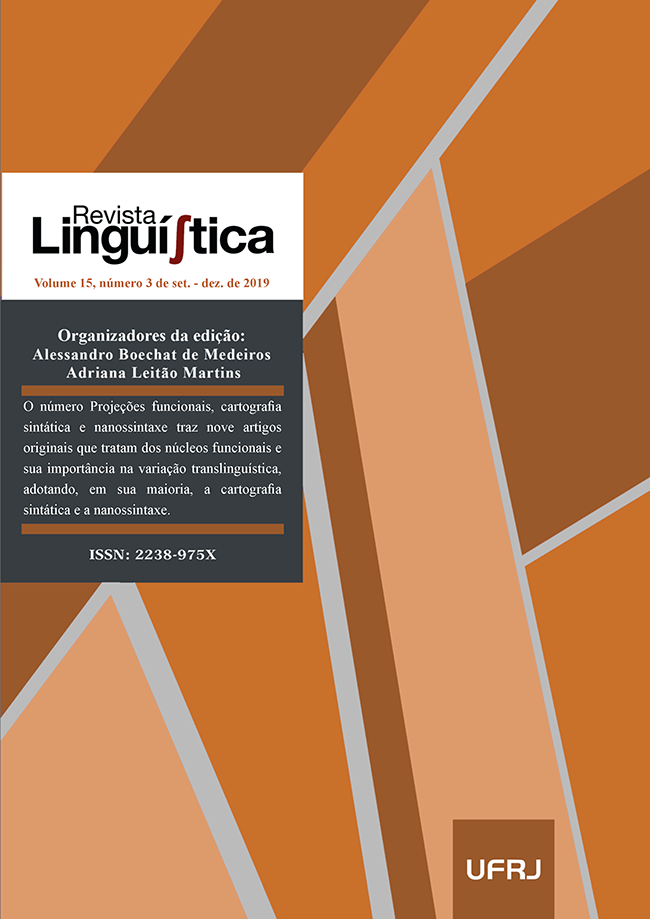Cartography and Microparametric variation: Criterial V2 in Swiss Romansh varieties
DOI:
https://doi.org/10.31513/linguistica.2019.v15n3a27546Palavras-chave:
Cartografia, Microparâmetros, Verbo em segunda posição, Romanche, Posições criteriaisResumo
In this article, I shall provide evidence for a theory of microparametric variation among Swiss Romansh varieties adopting a cartographic notion of parameter in terms of syntactic operations triggered by morphosyntactic features in functional projections. I shall discuss evidence showing how such a notion of parameter is extremely powerful in describing linguistic variability at a microlevel of the syntactic architectures. Adopting the guidelines of a Criterial V2, in which the inflected verb creates a Spec-Head configuration with the highest activated criterial head in the syntactic architecture, I shall observe microparametric variation within Swiss Romansh and with respect to other V2 languages, such as German. The language variability only relies on the interactions of basic factors, such as the presence of a functional projection and the syntactic operations triggered by the functional element. In the specific, it is possible to observe German and SR varieties vary in the activation of syntactic instructions in discourse related functional projections such as SubjP, ModP and ForceP. The role of morphosyntactic features thus describes in microparametric terms the richness of configurations predicted by cartographic guidelines and provide fine-grained typologies of set of languages.
--------------------------------------------------------------------------------------
CARTOGRAFIA E VARIAÇÃO MICROPARAMÉTRICA: V2 CRITERIAL EM VARIEDADES DO ROMANCHE SUÍÇO
Neste artigo, fornecerei evidências de uma teoria da variação microparamétrica entre as variedades do romanche suíço adotando uma noção cartográfica de parâmetro em termos de operações sintáticas desencadeadas por traços morfossintáticos em projeções funcionais. Discutirei evidências que mostram como essa noção de parâmetro é extremamente poderosa na descrição da variabilidade linguística em um nível micro das arquiteturas sintáticas. Adotando as diretrizes de um V2 criterial, no qual o verbo flexionado cria uma configuração Spec-Head com o núcleo criterial ativado mais alto na arquitetura sintática, observarei a variação microparamétrica no interior do romanche suíço em comparação com outras línguas V2, como o alemão. A variabilidade das línguas depende apenas das interações de fatores básicos, como a presença de uma projeção funcional e as operações sintáticas desencadeadas pelo elemento funcional. Especificamente, é possível observar que as variedades alemã e SR variam na ativação de instruções sintáticas em projeções funcionais relacionadas ao discurso, como SubjP, ModP e ForceP. O papel dos traços morfossintáticos descreve, assim, em termos microparamétricos, a riqueza de configurações previstas pela abordagem cartográfica e fornece tipologias refinadas de conjuntos de línguas.
---
DOI: http://dx.doi.org/10.31513/linguistica.2019.v15n3a27546
Downloads
Downloads
Publicado
Edição
Seção
Licença
Autores que publicam na Revista Linguí∫tica concordam com os seguintes termos:
Os autores mantêm os direitos e cedem à revista o direito à primeira publicação, simultaneamente submetido a uma licença Creative Commons que permite o compartilhamento por terceiros com a devida menção ao autor e à primeira publicação pela Revista Linguí∫tica.
Os autores podem entrar em acordos contratuais adicionais e separados para a distribuição não exclusiva da versão publicada da obra (por exemplo, postá-la em um repositório institucional ou publicá-la em um livro), com o reconhecimento de sua publicação inicial na Revista Linguí∫tica.

A Revista Linguí∫tica é uma revista do Programa de Pós-Graduação em Linguística da UFRJ e se utiliza da Licença Creative Commons - Atribuição-NãoComercial 4.0 Internacional (CC-BY-NC)









